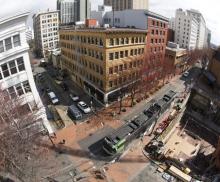revitalization

It’s easier to guide the vision and mission of a church you start. It’s another thing to help a 135-year-old congregation reimagine what it means to be a downtown urban church in a world that has changed dramatically all around it. At Milagro, the church we founded in our living room some nine years ago, we set the course for what we wanted that community to look like: a refuge for the spiritual walking wounded, safe haven for questions, doubt, and a culture of mutual encouragement, support, and accountability that would allow people to explore their own relationship with the Divine. We have since set that community free and already, it is becoming something different.
As well it should.
Now we find ourselves at First Christian Church in downtown Portland — a different animal entirely. In some ways, the two communities are very complementary, in that one has what the other tends to lack. But we’ve discerned that, first and foremost, our job is to help cultivate a spirit of radical openness and welcome. But what does this mean, and how do we even begin to change the makeup of an institution that has exited for more than five generations before us?
Sometimes, it’s the simplest things that say the most. We had a tradition at Milagro of “mugging” people when they came for the first time. This meant one of our hospitality stewards (AKA, “muggers”) would approach them and give them a coffee mug filled with candy and some information about the church. With First Christian, however, most people know we’re here; the bigger question lingering in the public mind is why.
In this case, instead of a brochure describing programs or institutional history, Amy included the welcome statement that follows, which she borrowed and adapted from a Catholic community.